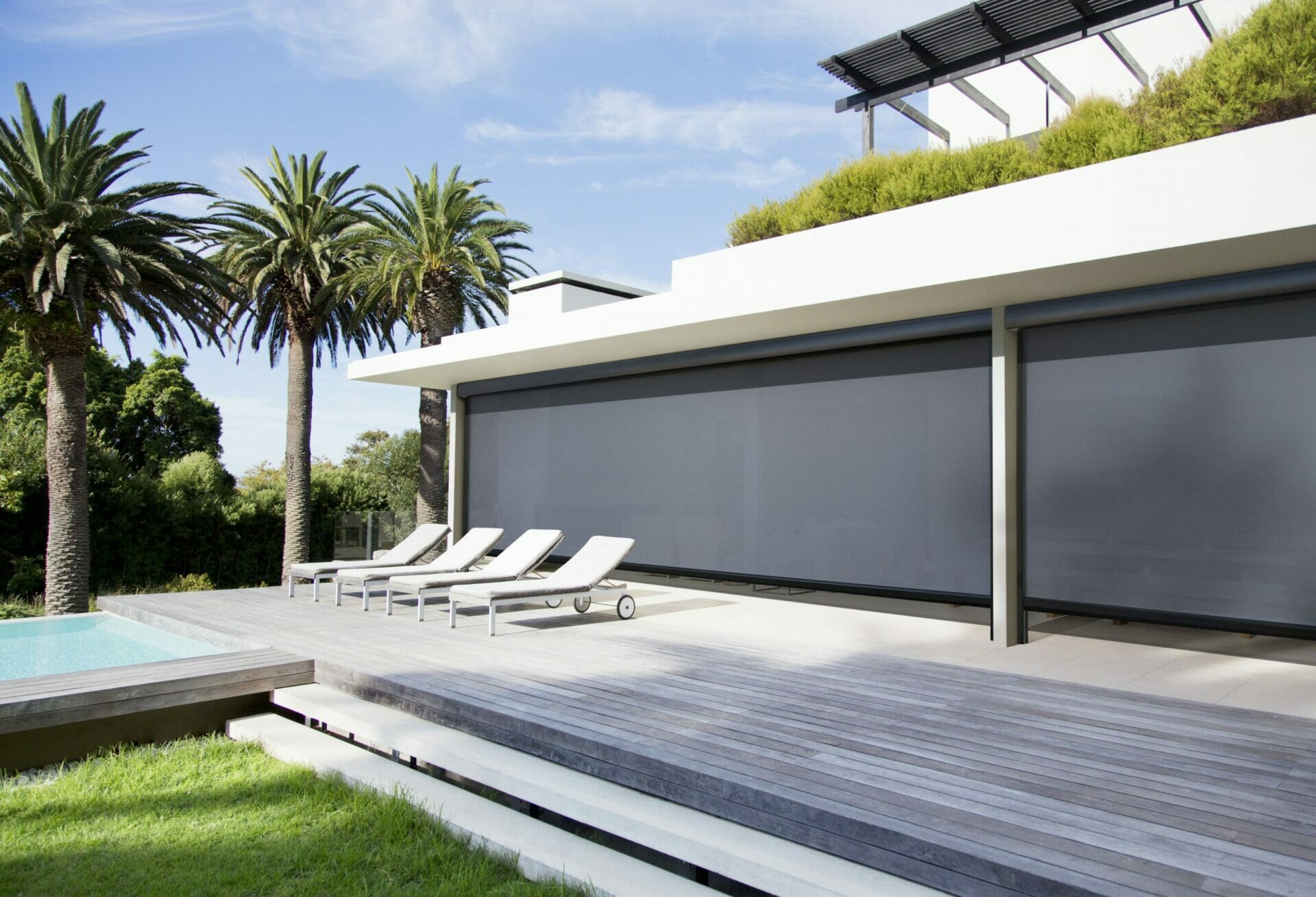Mastering MagnaTrack: A Dealer’s Guide to Progressive Screens’ Signature Technology
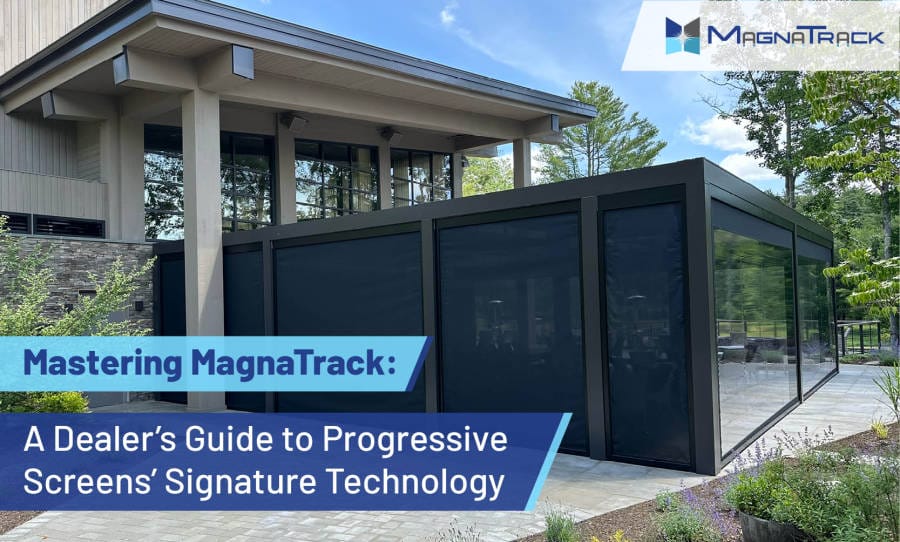
Whether you’re a general contractor or an exterior designer, your goal is to help your client achieve their vision with as little fuss as possible. That can be a challenge when you’re designing or building screened-in areas. People want a luxurious outdoor space that’s also highly convenient and not too high-maintenance.
As a Progressive Screens dealer, you know that’s possible with MagnaTrack. But how can you convince your customer? They need to hear all the benefits without a bunch of highly technical language.
Here’s our guide to MagnaTrack: how it works, how it’s better than the competition, and why it’s a great choice for your customers.
How a Typical Motorized Screen Works
In any retractable screen, the screen material coils around a roller. This is surrounded by a protective cover called the housing.
Inside the housing, a motor initiates the screen’s movement, whether up or down.
Once the screen starts rolling down, a weighted bottom bar helps gravity do its part. Of course, the screen needs to be guided to the floor so it doesn’t sway back and forth.
This is typically achieved with a Keder: a long, flat part that connects the screen to the track. It has a rounded edge—the “bead”—that fits into a cylindrical opening—the “rail.”
Unfortunately, a traditional Keder bead-and-rail system creates a lot of friction, wearing down the material over time. It can also sometimes get jammed, especially in long or curved tracks.
To solve this problem, many motorized screen manufacturers have switched to the ZipKeder, which is PVC tape with a series of “beads.” The beads “zip” into the track, so it’s more flexible.
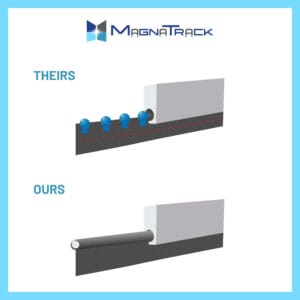
However, these zipper-type tracks don’t solve one major problem: wind pressure. As the wind pushes or pulls the screen, the Keder strains against the track. This eventually wears down the entire system—and in zippered screens, it could cause hang-ups or jams as the beads pop out of place.
In other words, the convenience of a retractable screen is defeated by the frustration level when something goes wrong. Traditional roll-down designs simply aren’t built to withstand the elements. And in places like Florida, that can be a dealbreaker.
How MagnaTrack Makes Retractable Screens Easier—and Stronger
After you’ve explained the drawbacks of a traditional bead-and-rail system (whether fixed or zippered), you can introduce MagnaTrack as the solution.
Here’s how it works:
Rather than a bead-and-rail, our screens’ sidetracks use a Keder interlock. As the name suggests, it’s a series of interlocking panels. This has two benefits:
- It securely guides the screen while allowing the track to “breathe,” expanding or contracting depending on wind pressure, ambient temperature, and so on.
- It houses the rare earth neodymium magnets, which provide tension to hold the screen in place.
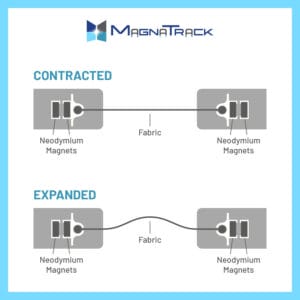
These features make MagnaTrack both self-adjusting and self-tensioning. Magnets of opposite polarities are drawn together, but they can move apart if needed—say, if a strong wind begins pulling the Keder away from the track.
The result? Our zipper-free system is impossible to jam, preventing 98% of the issues customers will experience with fixed-track or zipper systems.
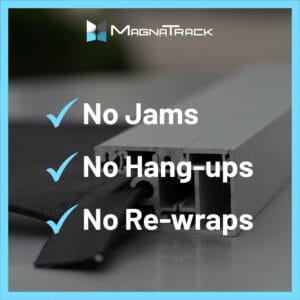
The Magic of Rare Earth Magnets
Rare earth magnets are a type of “permanent magnet,” meaning it has a constant magnetic field. They’re made from alloys of various metals, including rare-earth elements: soft metals with highly magnetic properties.
On a microscopic level, rare-earth magnets have a crystalline structure that keeps them from demagnetizing. These unique structures also make rare-earth magnets the strongest in the world.
The most common type of rare-earth magnet is neodymium. It’s an alloy of iron, boron, and neodymium—the rare-earth element. Neodymium magnets are about 18 times stronger than typical fridge magnets. They can lift other metal objects that weigh thousands of times what they do.
To better understand how neodymium magnets have such strength for products such as MagnaTrack, let’s review the basic science.
How magnets work
As we all learned in school, magnets have a north and south pole. This happens because the electrons inside the material’s atoms align to the Earth’s North or South Pole.
In a rare-earth magnet (or any permanent magnet), the material keeps its magnetic orientation.
When you bring the north pole of one magnet close to the south pole of another (or vice versa), they’re attracted to each other. Conversely, if you try to put the same poles together (north to north or south to south), the magnetic fields repel each other.
How we use neodymium magnets
When made into a permanent magnet, neodymium is quite strong. Put its north pole toward another magnet’s south pole, and they will snap together. Like your average fridge magnet, they’ll also attract most metal objects.
The MagnaTrack system puts those opposing polarities to work. The Keder interlock holds rows of neodymium magnets with their north and south poles pointed toward each other. That constant attraction keeps the track in alignment. This self-tensioning design is the hallmark of MagnaTrack—keeping it strong yet flexible enough to provide some leeway if something pushes the track inward (e.g., a heavy wind).
So, how strong are we talking?
Each inner track magnet has 75 lbs of pulling force per set, which means an average of 375 lbs of pulling pressure per track. That’s 750 lbs per set.
By comparison, a standard zipper system has springs that average 3-5 lbs of force. And a fixed-track may have mere foam or rubber with NO retraction features.
That’s why MagnaTrack has more than 10 times the pulling force of any other system on the market.
Multiple Benefits of MagnaTrack
MagnaTrack’s interlock track design helps reduce friction. Combined with the super-strong rare-earth magnets, this gives the system a long lifespan.
But MagnaTrack defends against more than wear and tear. By using the neodymium magnets, it ensures that the retractable screen can:
Withstand high winds and flying debris. Because the sidetracks can self-adjust and the magnets maintain tension, the MagnaTrack design dampens wind pressure and debris impact by almost 30%. It’s ideal for your clients in hurricane-prone areas.
Move smoothly around the curves. The dual-polarity magnet array creates a truly flexible, free-floating track, unlike the fixed or zipper-style Keders that can get snagged or jammed.
Self-correct if something does go wrong. By using magnets to create tension, your customer can simply reset the screen by raising it above the trouble spot. The track will automatically realign.
Pitching MagnaTrack to Your Customers
When selling MagnaTrack, emphasize its durability and ease of use. Motorized retractable screens are often a large investment. Your clients want to be sure they’re getting the benefits (insect-proofing, shade, etc.) without extra hassle. MagnaTrack’s innovative blend of neodymium power and self-correcting design makes it the perfect solution. Plus, it helps durable screens stay strong against the elements.
That combination of defense with luxurious comfort is highly attractive to your customers. Make it work for your business!
Need more information about how MagnaTrack works? Or want to add MagnaTrack to your toolkit and become a dealer? Get in touch today.

